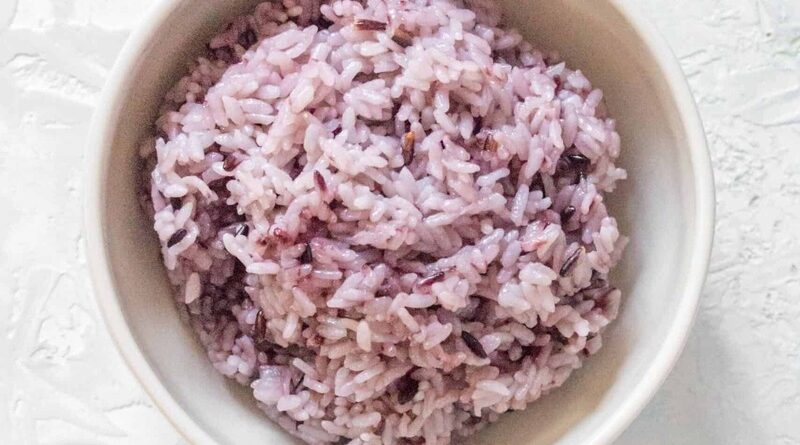Discover the Magic of Korean Purple Rice
Explore the charm of Korean purple rice, a delicacy with rich, vivid colors and a cultural mainstay. Examine its nutritional qualities, wide range of culinary uses, and expanding appeal worldwide. Discover the alluring recipes, health advantages, and growing secrets of this plant. Take a trip with us into the fascinating world of this grain, where creativity and tradition coexist on every dish.
Benefits of Korean Purple Rice for Nutrition
With so many nutritional advantages, Korean purple rice is a great complement to any diet. Purple rice, which is high in fiber, vitamins, minerals, and antioxidants, provides:
- Defense against inflammation and oxidative stress
- Support for regularity and health of the digestive system
- Control of blood sugar and cholesterol levels
- Support for heart health and a lower chance of developing chronic illnesses
- An alternative free of gluten for people with sensitivity
- Potential support for appetite control and weight management
Types and Growing Regions
Korean Purple Rice is made up of a variety of cultivars that are grown throughout Korea. In areas like Gyeonggi and Jeolla Provinces, varieties like Ssalbori and Heukjinjoo flourish. From the nutty flavor of Ssalbori to the fragrant aroma of Cheongdo Heukjinjoo, each type has something special to offer. The rich tapestry of Korean purple rice, which reflects the nation’s agricultural past and culinary diversity, is enriched by these growing regions.
Uses of Culinary Arts and Customary Dishes
A versatile ingredient with a long history in Korean cooking is Korean purple rice. It is the star of famous meals like bibimbap, which is elevated by its nutty flavor and vivid color.
It’s also a main ingredient in rice cakes, porridge, and sweets, giving traditional Korean cuisine a visual appeal and nutritional boost. Korean Purple Rice never fails to tantalize palates and stimulate culinary imagination across the globe, whether it is consumed in traditional recipes or creative fusion creations.
Korean Purple Rice Consequences for Health and Research Results
In addition to being aesthetically pleasing, Korean purple rice has numerous health advantages that have been verified by science. According to studies, the antioxidants in purple rice can lower the risk of chronic illnesses including cancer and heart disease by battling oxidative stress and inflammation. Its high fiber content also helps with weight management and intestinal wellness.
New research points to possible advantages for glycemic management and bone health. Including purple rice in your diet could be an easy yet powerful method to improve your general health and well-being.
Agriculture Methods and Ecological Balance
For sustained output, traditional farming practices are combined with contemporary agricultural techniques in the growth of purple rice in Korea. Crop rotation, precision farming, and water-saving irrigation are some of the techniques farmers use to maximize productivity while maintaining soil fertility and biodiversity.
Long-term sustainability in purple rice cultivation is fostered by programs that support environmental care and community engagement, which maintain a balance between agricultural productivity and ecological resilience.
Recipes and Cooking Advice
Korean purple rice’s distinct flavor and vivid color make cooking with it a fascinating culinary experience. Here are a few short guidelines to help you prepare the ideal purple rice:
Rinse Well:
To get rid of extra starch, give the rice a thorough rinse in cold water before cooking.
Use the Correct Ratio:
For fluffy grains, adhere to the suggested water-to-rice ratio.
Soak for Better Texture:
To achieve a better texture, soak the rice for thirty to sixty minutes.
Try Different Cooking Techniques
For further adaptability, try stovetop, rice cooker, or Instant Pot techniques.
Boost Flavor:
To add more flavor depth, add aromatics like ginger, garlic, and sesame oil.
To get the most out of Korean purple rice, try these recipes:
Bibimbap:
A vibrant bowl of mixed rice with gochujang sauce and a variety of vegetables on top.
Korean Purple Rice Salad:
Mix cooked rice with colorful fruits and vegetables and a zesty vinaigrette.
Purple Rice Porridge:
For a hearty supper, cook rice in broth with veggies and protein.
Purple Rice Pudding:
To make a creamy dish, cook rice with coconut milk and sugar.
Purple Rice Sushi Rolls:
For a vibrant take on sushi, roll rice with avocado, cucumber, and fish.
Conclusion
In summary, Korean purple rice is a cultural icon and nutritious powerhouse in addition to being a delectable food. It is a great complement to any diet because of its vibrant colors, many applications, and health advantages. Its attraction knows no geographical boundaries, enticing palates all around the world with its inventive fusion recipes and traditional cuisine.
When we examine Korean purple rice’s production techniques, culinary uses, and health benefits, it becomes clear that this rice is a harmonious fusion of tradition and innovation that promises both gourmet delight and overall well-being. Take a trip with this colorful grain and experience each meal as a celebration of creativity and heritage.
You Can Read More About Korean Rice
Easy Homemade Korean Rice Cake Soup Recipe
